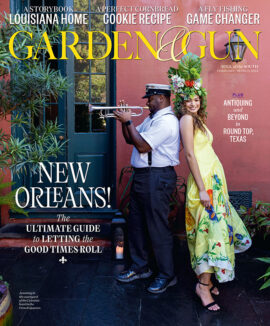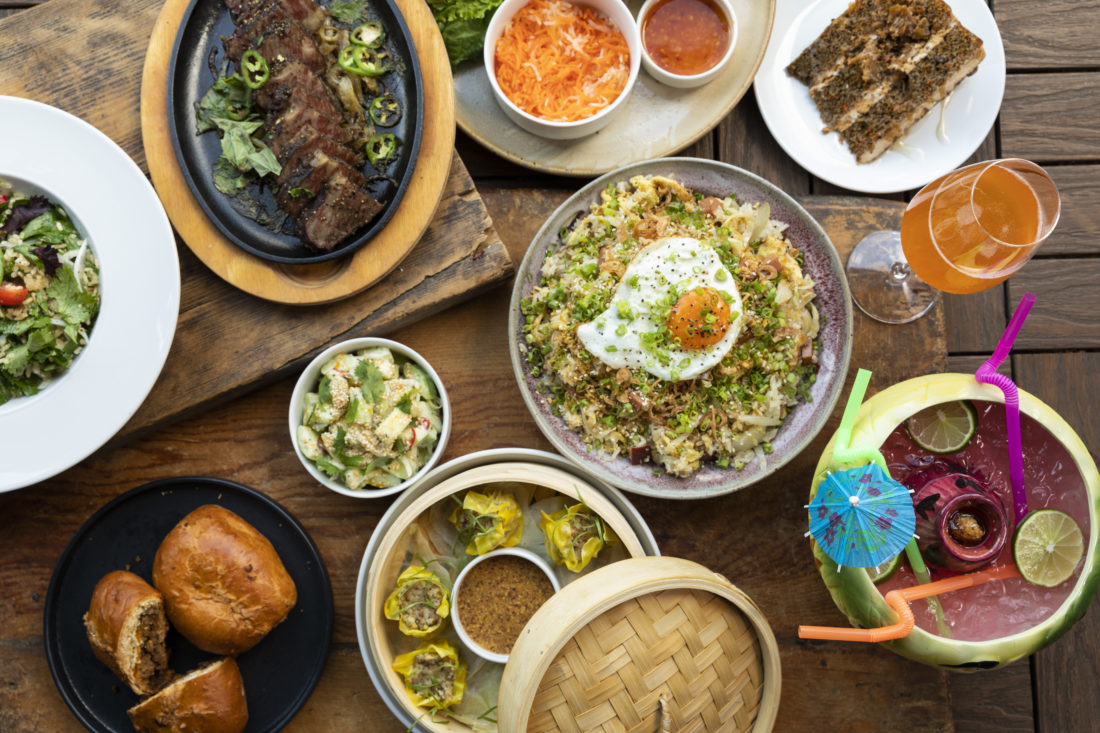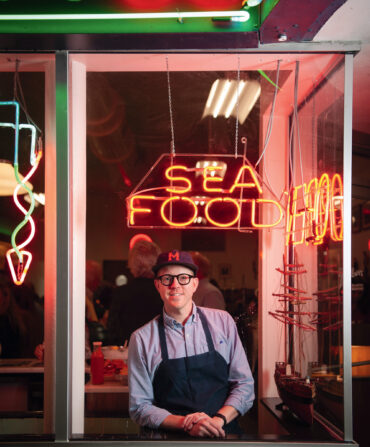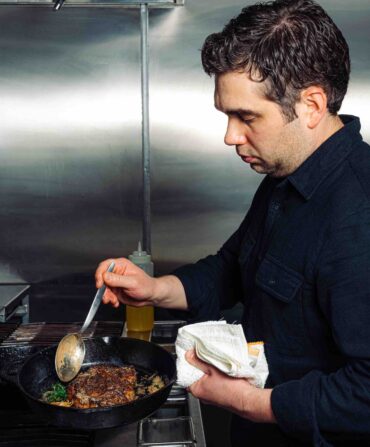Every year, a new crop of restaurants continues to expand the universe of Southern food. In Asheville, for example, chefs John Fleer and Ashleigh Shanti began exploring the intersection where Appalachian cooking meets African-American traditions at Benne on Eagle, which opened this November. At Houston’s UB Preserv, which opened in May, chefs Chris Shepherd and Nick Wong showed diners a whole new way to cook collards. Those are two of the five restaurants, presented here in alphabetical order, that kept us excited this year—both to eat and to see where Southern food goes next.
Benne on Eagle
Asheville, North Carolina
Opened: November 2018
benneoneagle.com
How easy it is to fall hard for the progressive spirit of Asheville—a place of drum circles and street buskers, meditation retreats and organic food co-ops. If you love to eat and drink, you will likely gravitate toward that tangle of downtown-adjacent streets where such diverse outfits as Katie Button’s Spanish restaurant Cúrate, French Broad Chocolate Lounge, and Wicked Weed Brewing Pub lend a worldly personality to this Smoky Mountain town.
Yet like all Southern cities, the surface charm belies a complicated history. This area, long known as “The Block,” was once Asheville’s most prominent African-American neighborhood. From the 1920s through the 1990s it was a place of segregation but then also of pride, business, and community. The just-opened Foundry Hotel, set in The Block’s historic center, celebrates that history with its restaurant, Benne on Eagle.

Photo: Johnny Autry
Ashleigh Shanti.
Chef John Fleer and his firebrand chef de cuisine Ashleigh Shanti have devised a menu that draws on black Appalachian cooking, blending in West African tradition. Standouts include accara (black-eyed pea fritters) with sorghum mustard and piri piri yogurt, and spiced oxtail with curried onions—a nod to the popularity of oxtails at restaurants on The Block during its heyday. There may be pork ribs, but they’re first rubbed with ground ogbono, a seed popular in Nigerian cooking.
“The menu is really intended to be a look backward to the West African roots of Southern food,” says Fleer, a chef by trade and a bookish historian by temperament, who owns the nearby favorite Rhubarb and was the longtime chef at Blackberry Farm. Helping him keep it real is Hanan Shabazz, who ran Shabazz Soul Food on Market Street in the 1960s. “Miss Hanan is famous for her fish cakes,” continues Fleer, “which we’re going to turn into a fish burger. She’s also working with the pastry chef to see if we can get close to her sweet potato pies and bean pies. Everyone says they were extraordinary.”

Photo: Johnny Autry
Grilled Hickory Nut Gap pork chop with glazed sweet potatoes, collard greens, and onion gravy.
Folk
Nashville, Tennessee
Opened: April 2018
goodasfolk.com
If you’ve ever eaten at Rolf & Daughters—Phil Krajeck’s six-year-old spot in Nashville’s restaurant-packed Germantown neighborhood—you know that his handmade pastas are the come-ons and that his entrees are sexy. But his salads and vegetable-centered small plates, which thrum with an ever-surprising intensity of flavor, are what really earn your love.

Photo: Courtesy of Folk
Phil Krajeck.
For his sophomore effort, Folk, Krajeck moved across the Cumberland River to East Nashville and he follows basically the same menu format at Rolf & Daughters, replacing pasta with pizza. First consider those pizzas—prepared with the skills he learned working at Franny’s and Roberta’s in Brooklyn and with flours from two local mills he has delivered biweekly to keep at the peak of freshness. (“My goal was to find a really great wheat based on agriculture rather than the commodities market,” he says.) One pizza might arrive scattered with just-shucked clams, reduced clam cream, Japanese fish flakes, and chile oil; another rethinks the Hawaiian with spit-roasted pineapple, crushed tomato, pickled chiles, and mozzarella.
You also might flirt with a dry-aged New York strip basted in beef garum (fermented beef drippings) on the grill. But save yourself (or at least enough appetite) for the vegetable plates: Krajeck has real gift for building clean and impeccably seasonal ingredients that communicate without excess fat or salt. As long as it’s in season, look for his spiralized kohlrabi Caesar with shaved sheep’s milk and smoked trout roe. If you see squash on a Krajeck menu—say, sonca squash with marigolds, mizuna, buttermilk and pumpkin seeds—don’t think twice, just order.

Photo: Courtesy of FOLK
A night at Folk.
Petra and The Beast
Dallas, Texas
Opened: March 2018
petraandthebeast.com
If you visit Petra and the Beast looking for an appetizer, an entrée, and a hovering waiter, you’re out of luck. Most nights of the week, chef/owner Misti Norris takes orders at the counter and serves her boundary-pushing creations in the kind of paper boats that usually contain chili cheese fries. Then on Saturdays, she shoots the moon, offering a plated 14-course blowout meal built around whole-animal utilization and whatever she has curing and pickling in the kitchen.

Photo: Sydni Herbert
Pickles and vinegar at Petra and the Beast.
Norris, one of the most creative spirits to emerge from the world of Dallas fine dining, ran Petra and the Beast as a pop up before taking her alliterative four-point mantra—“farm, forage, fermentation, fire”—to a converted gas station in East Dallas. The thirty-five lucky souls who can squeeze in arrive with six-packs and bottles of wine and order dishes that sound like nothing on record. Grilled chicken hearts arrive with garlic chive cakes, while crispy pig tails may share space with a conserva of scallions, potatoes cooked in vinegar brine, burnt rice, and mustard frills. Most diners round out the meal with one of the exemplary charcuterie boards.
Norris’ culinary imagination thrusts her cooking into new territory, unencumbered by the gravitational pulls of tradition and familiarity. So when she tells you that she smokes beef tongue with anchovy and sake lees before setting it in its paper boat with cold-fermented cucumbers and hot mustard ricotta, you don’t stop to visualize this dish. You just say, “Yes, please,” and prepare for liftoff.

Photo: Sydi Herbert
Lasagnette and puffed skin.
Tiny Lou’s
Atlanta, Georgia
Opened: June 2018
tinylous.com
When word swept through Atlanta that the near-derelict Hotel Clermont would be renovated into a boutique property, the city held its collective breath. The citizenry thought little of the hotel itself, which had long been popular with single men of modest means renting by the month. But they were deeply attached to its basement resident, the Clermont Lounge, where the drinks were cheap, the grime thick, and the sexagenarian strippers so highly revered they qualified as Atlanta celebrities.

Photo: Asher Moss
The entrance to Tiny Lou’s.
Folks need not have worried. The lounge and its elderly ecdysiasts were left in all their glory while, just above it opened a restaurant with an attitude so different you can’t believe it shares a roof. “I’ve never sold so much foie gras in my life,” laughs Jeb Aldrich, the chef at the elegant, impeccable and oh-so-French Tiny Lou’s. Le tout Atlanta shows up for cocoa-cured foie gras with apricot-tinged sauce Caline as well as pellucid duck consommé with foie gras dumplings. These diners want the classics that read as French and resonate as Southern, such as a pitch-perfect trout amandine served with organic, seasonal vegetables. They spend, they drink, and after dinner they head up to the rooftop patio with its view of the BeltLine, or down to the Lounge, where Blondie has a ready-to-crush beer can with your name on it.
Most of all, they love the way this restaurant intimates a halcyon past—Tiny Lou was a performer in the 1950s cabaret that preceded the lounge—even as it remains firmly in the present of an anything-goes city. Leave it to Atlanta to crack the code on gentrification.
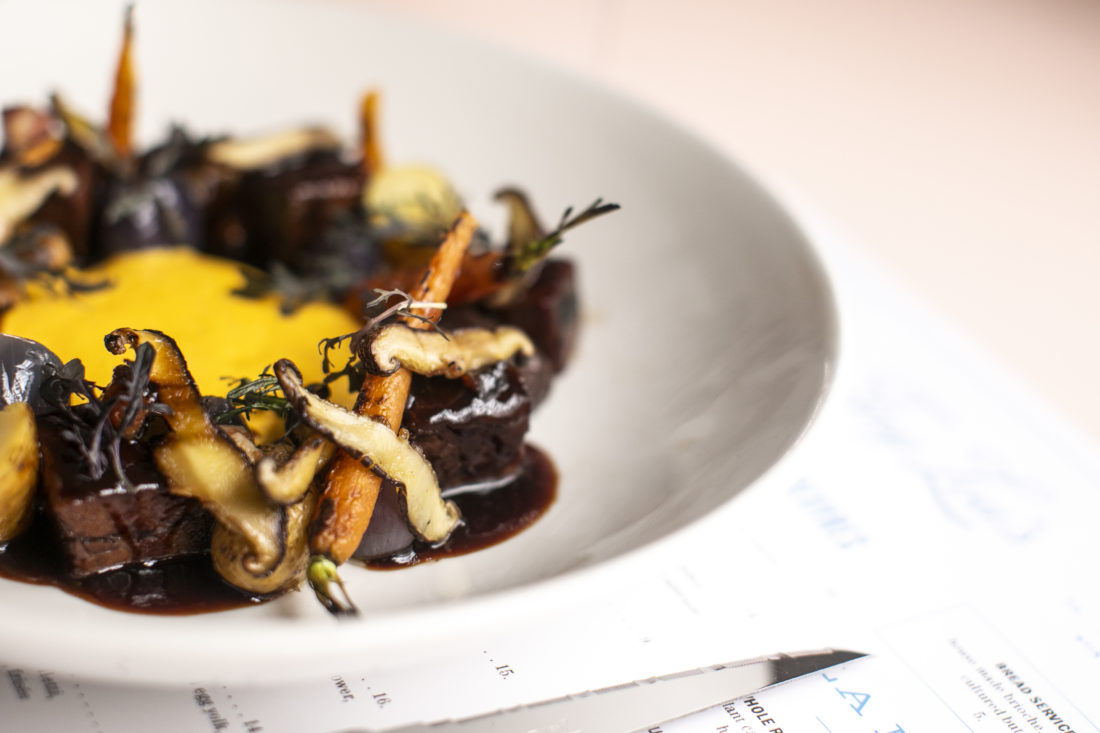
Photo: Heidi Geldhauser
Beef Bourguignon at Tiny Lou’s.
UB Preserv
Houston, Texas
Opened: May 2018
ubpreserv.com
When Chris Shepherd was walking around New York City, planning the casual restaurant that would replace his high-end Houston flagship Underbelly, he saw a sign. An actual sign, hitched to the side of a building, although the banner had lost a tie and flapped over itself so that it read “Preserv.” That was it—the name for the restaurant that would preserve Underbelly’s mission of telling the story of Houston food, a work in progress, always evolving, never finished.
“That’s what makes our city as good as it is,” Shepherd says. “We promote each other and learn from each other. Everyone here has a story to tell.” Photographs set throughout the restaurant showcase not just local farmers and artisans and other lauded chefs, but also a tiny Vietnamese place Shepherd stumbled into for “one of the best banh xeos I’ve ever had” and of a nearby Middle Eastern meat-and-three that’s a staff lunch favorite. Homages to one and all show up on the menu.

Photo: Julie Soefer Photography
Nick Wong.
Shepherd hired Nick Wong, a New Yorker with a stellar resume, to helm the kitchen. But first Wong had to explore his new home. “Getting Nick to know Houston through my eyes was like turning on the lights,” Shepherd says. After trying boudin and then a fine dim sum house, he invented boudin shu mai in red rice wraps. He stuffed chicken galantine with a version of Chinese lotus leaf sausage rice, and he considered the crispy rice salads popular in Southeast Asian cuisines, but made one that was lighter on the tongue, acid-bright, and fragrant with fresh herbs. Wong’s wok-fried threads of collard greens with ham hock jus and hot sauce quickly became UB Preserv’s must-order dish—a familiar flavor in a wholly new context that says Houston today.

Photo: Julie Soefer Photography
Wok-fried collard greens at UB Preserv.

